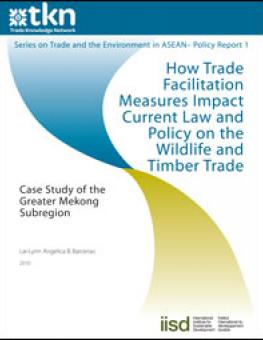
How Trade Facilitation Measures Impact Current Law and Policy on the Wildlife and Timber Trade: Case study of the Greater Mekong Subregion
As biodiversity within the Greater Mekong Subregion (GMS) continues to be threatened by rampant and unchecked trade in wildlife and timber, developments in infrastructure, telecommunications and trade within the subregion are threatening to worsen the situation. While these improvements ease the movement of people and goods across borders, they also provide illegal traders of wildlife and timber easy access to these improved facilities as they continue to transport their goods.
This case study examines the current state of biodiversity in the GMS and the effect of international trade on its wildlife population and forest cover. It examines how the current trade facilitation measures at the multilateral, regional and subregional levels could potentially affect the growth of illegal wildlife and timber trade. It also assesses their impact on current efforts to combat such trade and the subregion's capacity to address the new challenges posed by trade facilitation measures.
Key findings:
-
Global demand for wildlife and timber is already depleting the rich habitats of the GMS. The increased facility in the movement of goods across international borders that these trade facilitation measures would provide could further exacerbate such depletion.
-
It is important for policymakers to carefully assess the emerging trade facilitation mechanisms and processes and determine potential risks and opportunities in curbing the unsustainable harvest of wildlife and timber, and their attendant trade.
-
Controlling and regulating wildlife and timber trade is part of a whole set of conservation measures being implemented in the GMS and within the ASEAN region in compliance with obligations of the GMS and ASEAN states under the Convention on International Trade in Endangered Species and the Convention on Biological Diversity.
-
In addition, as part of the ASEAN integration process, ASEAN has set out policy guidelines for the promotion of the sustainable use of biodiversity and the prevention of illegal wildlife and timber trade.
Key recommendations:
As GMS states implement these trade facilitation measures, they must:
-
Identify existing constraints, whether inherent or institutional, that hamper efforts to address the unsustainable harvesting of wildlife and timber and their attendant trade;
-
Determine actions necessary to address these constraints in order to mitigate or neutralize the adverse effects of these trade facilitation measures. In particular:
-
rationalize and assess the effectiveness of all measures related to biodiversity, conservation and wildlife and forest law enforcement to identify overlaps and gaps;
-
assess how current negotiations on the proposed WTO trade facilitation agreement in the Doha Development Round can ensure that the final draft leaves room for the effective regulation of wildlife and timber trade;
-
coordinate with customs authorities in assessing the vulnerabilities of the various trade facilitation agreements, particularly the Cross Border Transport Agreement, to exploitation by illegal wildlife and timber traders.
-
assess whether the identified border checkpoints under the Cross Border Transport Agreement are located in areas where smuggling is prevalent and whether these are equipped to deal with such smuggling activities;
-
negotiate a new protocol to the Cross Border Transport Agreement dealing with the transport of wildlife and timber that imposes stricter requirements for transit through and entry into neighbouring states;
-
harness existing international initiatives, such as: the Forest Law Enforcement, Governance and Trade (FLEGT) Action Plan of the European Union (EU) and the International Tropical Timber Organization (ITTO)-CITES Program for Implementing CITES Listings of Tropical Timber Species.
-
You might also be interested in
Tree Planting for Climate Resilience in Freetown, Sierra Leone
This assessment presents the economic valuation of tree planting efforts in Freetown, Sierra Leone, including planting costs, added benefits, and avoided costs.
Sustainable Asset Valuation of Sherwan Hill Adventure Park in Abbottabad, Pakistan
This report analyzes the social, economic, and environmental benefits of the Sherwan Hill Adventure Park in Pakistan.
December 2024 | Carbon Minefields Oil and Gas Exploration Monitor
In November 2024, 23 oil and gas exploration licences were awarded across five countries, with Russia granting the licences that account for the largest portion of embodied emissions.
Toward a Coherent, Transformative Approach to Financing Sustainable Development, Climate, and Nature
Four key proposals for the Fourth Financing for Development Conference (FfD4) to create an integrated, equitable approach to financing climate, nature, and development goals.